Lebanese Spinach Pies, known as Fatayer Bi Sabanekh in Arabic, are a cherished culinary delight, deeply embedded in the heart of Middle Eastern gastronomy. These delightful savory pastries feature a soft, airy dough generously filled with a vibrant mixture of spinach, onions, and a medley of zesty spices, most notably the distinctive sumac. The result is a truly unique flavor profile – a perfect balance of earthy spinach, sweet caramelized onions, and an invigorating sour zing that tantalizes the taste buds. More than just a snack, Fatayer Bi Sabanekh represents comfort, tradition, and the joy of shared meals in Lebanese homes. They are incredibly versatile, perfect as a light breakfast, an elegant appetizer, a hearty side dish, or even a satisfying lunch. What’s more, these homemade treats are remarkably freezer-friendly, allowing you to enjoy their authentic flavors at a moment’s notice.

Hailing from the Levant region, Fatayer are more than just pastries; they are a cultural cornerstone. Each bite of these spinach pies is packed with the distinctive flavors of the Mediterranean, with sumac being the star that imparts their signature tangy taste. They’re often served alongside other mezze items, making them an indispensable part of any Lebanese spread. Their delightful sourness makes them particularly refreshing, distinguishing them from other savory pastries. For those who appreciate the robust flavor of spinach in a pastry, you might also enjoy exploring other Mediterranean delights like Easy Spanakopita Triangles, though the unique tang of Fatayer truly sets it apart.
What Exactly Are Lebanese Spinach Pies?
Lebanese Spinach Pies, or Fatayer Bi Sabanekh, are wholesome and nutritious pastries that hold immense popularity across the Levant. The term “Fatayer” itself is a broad classification in Middle Eastern cuisine, referring to various small pastries often filled with different ingredients. While the possibilities for fillings are endless – ranging from spiced ground meat to various cheeses – spinach fatayer remains one of the most beloved and iconic varieties.
The magic of these pies lies in their exquisite filling, a carefully balanced blend of fresh or thoroughly drained spinach, delicately caramelized onions, finely diced tomatoes, and a crucial array of seasonings. Black pepper and salt lay the foundation, but it’s the combination of sumac and lemon juice that truly elevates the flavor profile, infusing the filling with its characteristic citrusy tang. For those desiring an even more pronounced sourness, some traditional recipes incorporate a touch of citric acid in place of a portion of the lemon juice, or a drizzle of pomegranate molasses, which adds a complex, sweet-tart depth. These pies are not just delicious; they are a nutritional powerhouse, offering a wonderful way to enjoy spinach.
Why You’ll Fall in Love with Lebanese Spinach Fatayer
There are countless reasons why Lebanese Spinach Fatayer has captivated hearts and palates for generations. Beyond their delicious taste, these savory pies offer unparalleled convenience and satisfaction:
- Effortlessly Delicious & Easy to Make: Don’t let their elegant appearance fool you; these fatayer are surprisingly simple to prepare. The recipe utilizes readily available pantry staples that you likely already have on hand. The process, while requiring a bit of kneading and shaping, is straightforward and incredibly rewarding, making it an ideal project for both novice and experienced bakers.
- A Symphony of Flavors: Each bite of a Lebanese Spinach Pie is an explosion of balanced flavors. The earthy notes of spinach perfectly complement the sweetness of caramelized onions and the freshness of tomatoes. The star, sumac, contributes a bright, tangy kick, while lemon juice and optional pomegranate molasses add layers of citrusy and sweet-tart complexity. It’s a harmonious blend that leaves a lasting impression and keeps you coming back for more.
- Your Freezer’s Best Friend: One of the most practical aspects of these spinach pies is their exceptional freezer-friendliness. Preparing a large batch means you can have a gourmet appetizer, side dish, or snack ready whenever you need it. They reheat beautifully, maintaining their delicious flavor and texture, making them an invaluable asset for meal prepping, unexpected guests, or simply when you crave a taste of the Levant without the immediate effort.

Crafting the Perfect Lebanese Spinach Pie: Essential Ingredients
The journey to the perfect Lebanese Spinach Pie begins with two main components: a tender, pliable dough and a richly seasoned spinach filling. Preparing the dough first allows it ample time to rise, during which you can meticulously prepare the flavorful stuffing.
Fatayer Dough Ingredients
The foundation of an authentic Fatayer is its dough – light, soft, and slightly chewy. Here’s what you’ll need to create this essential base:
- All-Purpose Flour: The go-to choice for this recipe, providing the ideal gluten structure for a tender yet resilient dough. Bread flour can also be used for a slightly chewier texture.
- Warm Water: Crucial for activating the yeast, ensuring your dough achieves a beautiful, airy rise.
- Lukewarm Full-Fat Milk: Adds richness and softness to the dough, contributing to its luxurious texture and flavor.
- Baking Powder: Works in conjunction with yeast to provide an extra lift, resulting in an even lighter pastry.
- Granulated Sugar: Essential for feeding the active yeast, helping it to bloom and create carbon dioxide for rising.
- Neutral-Flavored Oil: Such as vegetable or canola oil, to contribute moisture and elasticity to the dough without imparting an overpowering flavor.
- Salt: A fundamental seasoning that enhances the overall flavor of the dough and balances the sweetness.
- Active Dry Yeast: The leavening agent responsible for making the dough rise, giving the fatayer their characteristic soft and pillowy texture.
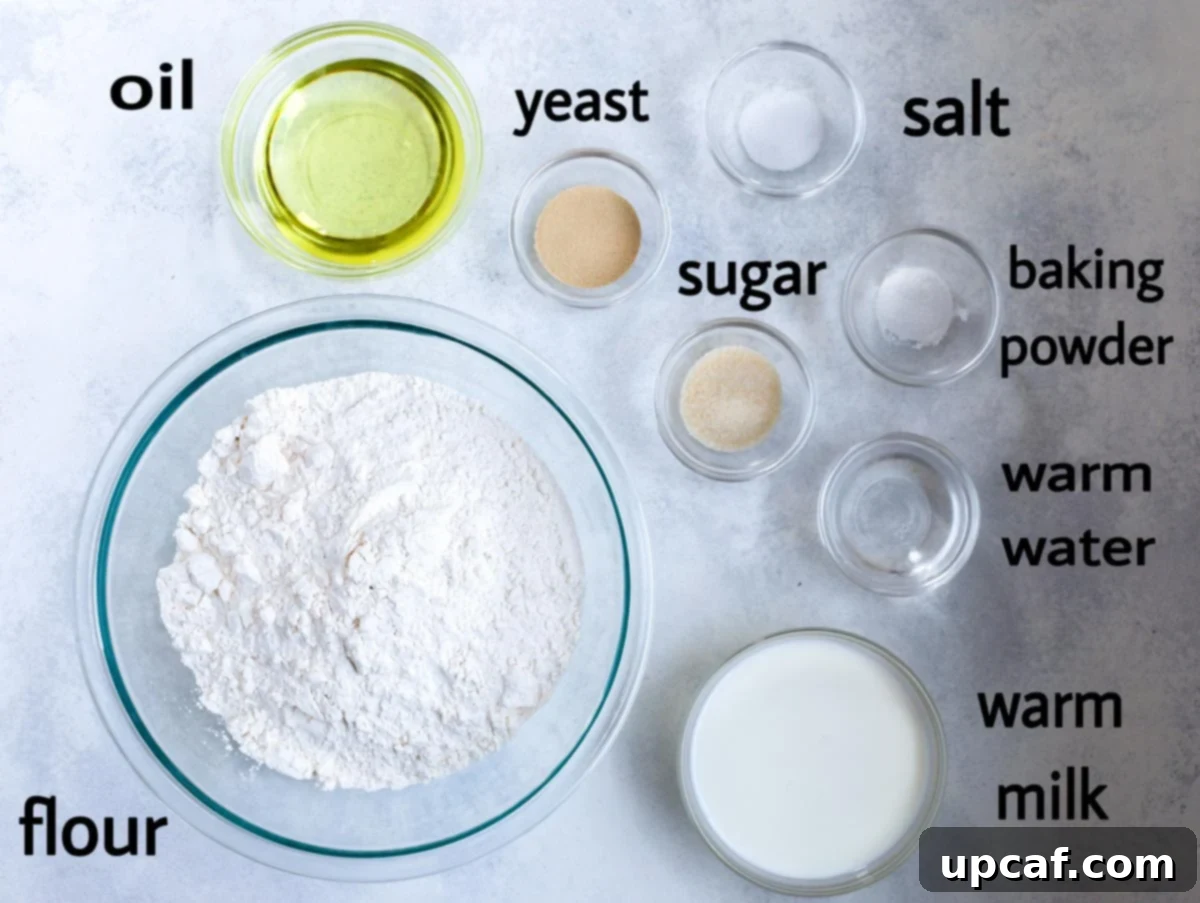
Preparing the Dough:
Begin by activating your yeast. In a small cup, combine the active yeast with warm water and sugar. Stir gently and allow this mixture to sit undisturbed for about 10 minutes. This critical step ensures the yeast is alive and active; you’ll know it’s ready when the mixture becomes foamy and visibly doubles in size. If it doesn’t foam, your yeast may be old or the water temperature was incorrect, and you should start over.
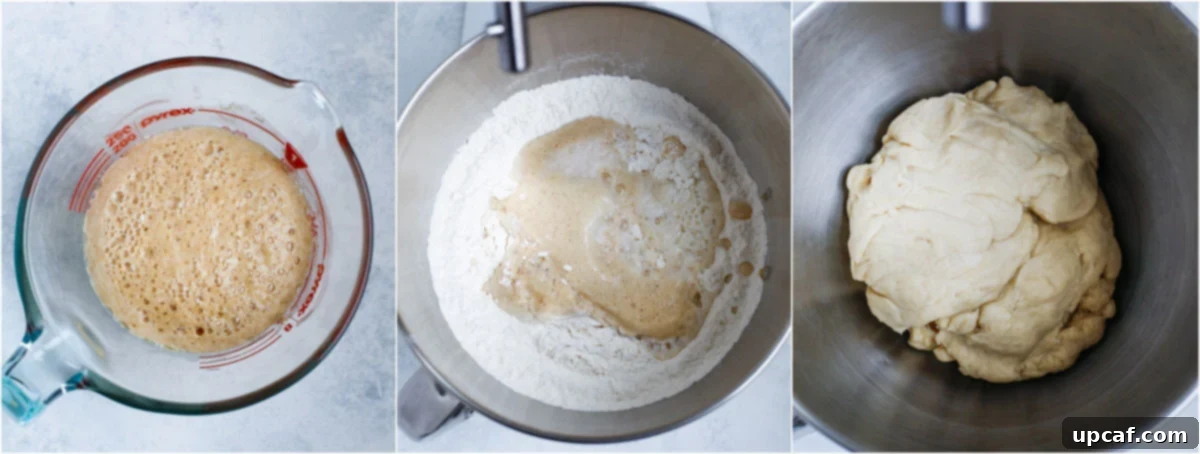
Once your yeast is active, proceed to mix the dough. In the bowl of an electrical mixer fitted with a dough hook, combine all the dry ingredients (flour, baking powder, and salt). Pour in the activated yeast mixture, then gradually add the warm milk and oil while the mixer runs on a low speed. Continue to knead the dough for several minutes until it comes together into a smooth, elastic ball that pulls away cleanly from the sides of the bowl.

Remove the dough from the mixer and shape it into a neat, round ball with your hands. Lightly grease the mixing bowl with a spray of oil, return the dough to the bowl, and cover it tightly with a kitchen towel or plastic wrap. Allow the dough to rise in a warm place for 45 minutes to 1 hour, or until it has delightfully doubled in size, as depicted in the photo below. This rising time is crucial for developing flavor and creating a light texture.
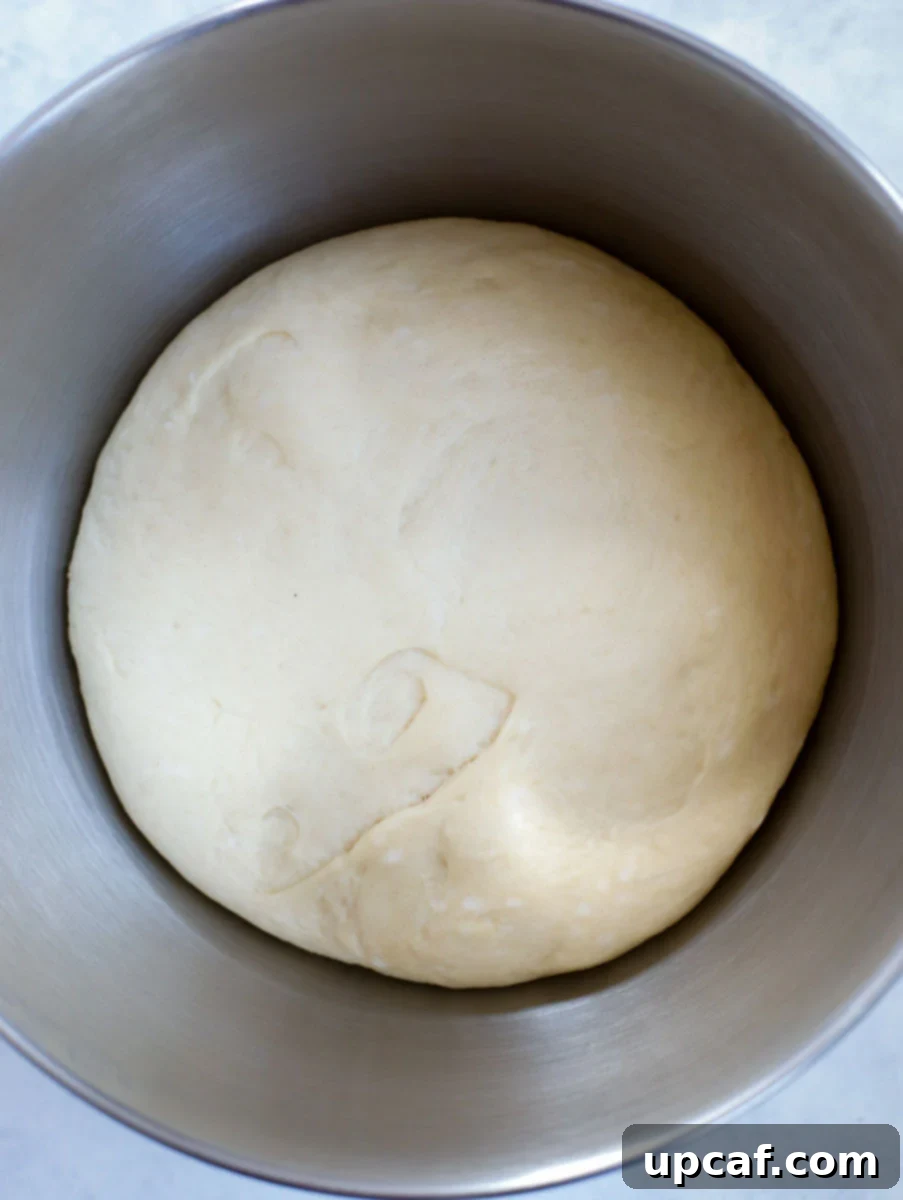
While the dough is patiently rising, it’s the perfect opportunity to prepare the vibrant and aromatic spinach filling that will bring your fatayer to life!
Spinach Fatayer Filling Ingredients
The heart of these pies is a robust and tangy spinach filling. Each ingredient plays a vital role in creating its signature taste:
- Spinach (Fresh or Frozen): Fresh spinach is highly recommended for its superior texture and flavor. However, frozen spinach can be a convenient alternative; just ensure it’s completely thawed and thoroughly squeezed to remove every drop of excess water, which is paramount to prevent soggy pies.
- Lemon Juice or Citric Acid: Fresh lemon juice provides a bright, natural tang. For an intensified sourness or if fresh lemons are unavailable, a small amount of citric acid can be used as a replacement.
- Black Pepper and Salt: Basic seasonings that form the flavor base, enhancing the natural taste of the vegetables and spices. Adjust to your personal preference.
- Sumac: An indispensable spice in this recipe. Sumac, derived from dried and ground berries, imparts a unique, tart, and slightly fruity flavor that gives these pies their signature zing. Do not skip this!
- Fresh Diced Tomatoes: Adds a touch of sweetness, moisture, and a fresh, bright counterpoint to the spinach and sumac. Use ripe, firm tomatoes for the best results.
- Onion (Petite Diced and Sautéed): Caramelizing the finely diced onions until they are translucent and slightly golden mellows their pungency and brings out their natural sweetness, adding depth and richness to the filling. This step is critical for flavor development.
- Pomegranate Molasses (Optional): A thick, tart syrup made from reduced pomegranate juice. A drizzle of this can add a wonderful sweet-tart complexity and a deeper color to the filling.
- Chili Flakes (Optional): For those who enjoy a subtle hint of heat, a pinch of chili flakes can add an exciting kick without overpowering the other flavors.
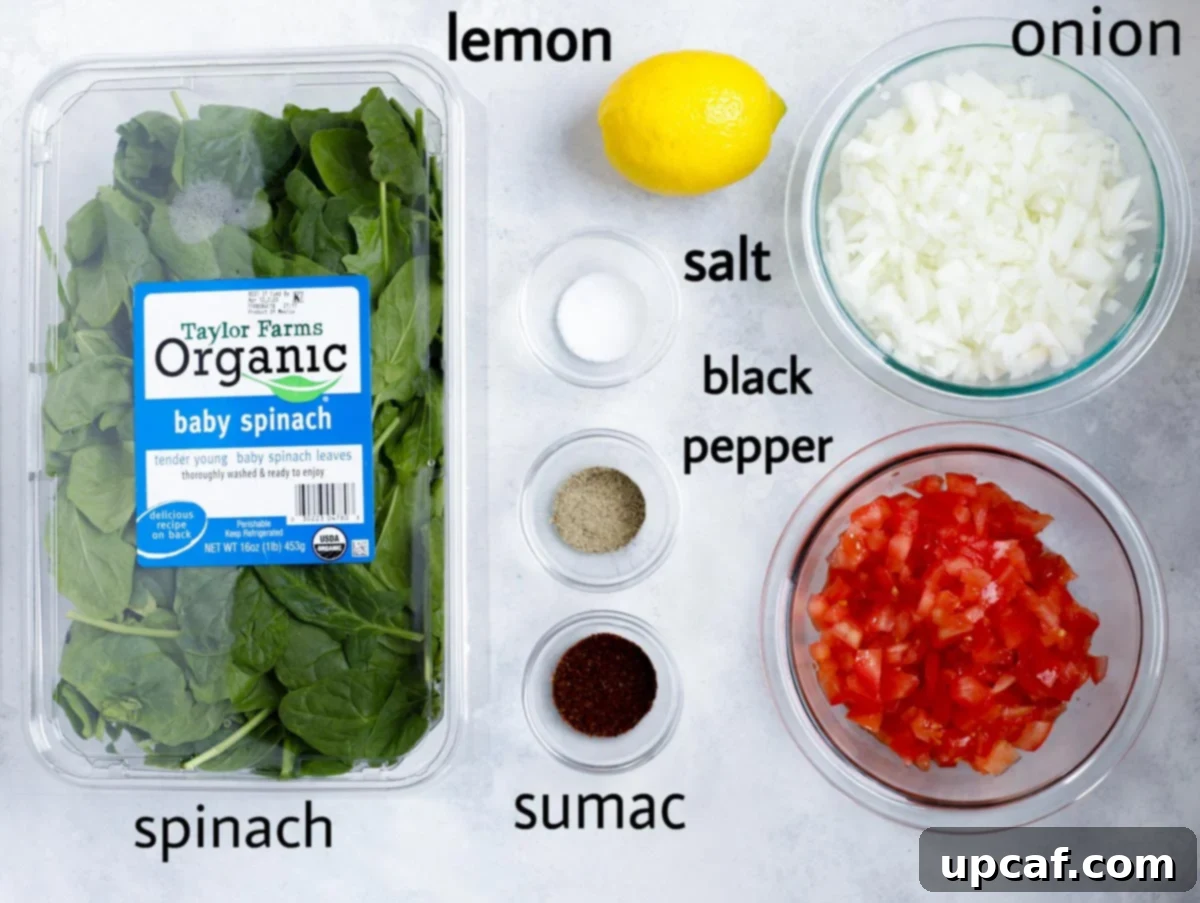
Preparing the Filling:
The first step in crafting the filling is preparing the spinach. If using fresh spinach, heat a tablespoon of olive oil in a large pot or skillet and sauté the roughly chopped spinach just until it wilts and shrinks. Immediately transfer the blanched spinach to a strainer and allow it to drain and cool completely. Once cool enough to handle, firmly squeeze out any remaining liquids using your hands or a clean kitchen towel. This step is crucial; excess moisture will make your pies soggy. If using frozen spinach, simply thaw it completely and then squeeze out all the liquids until it is as dry as possible.
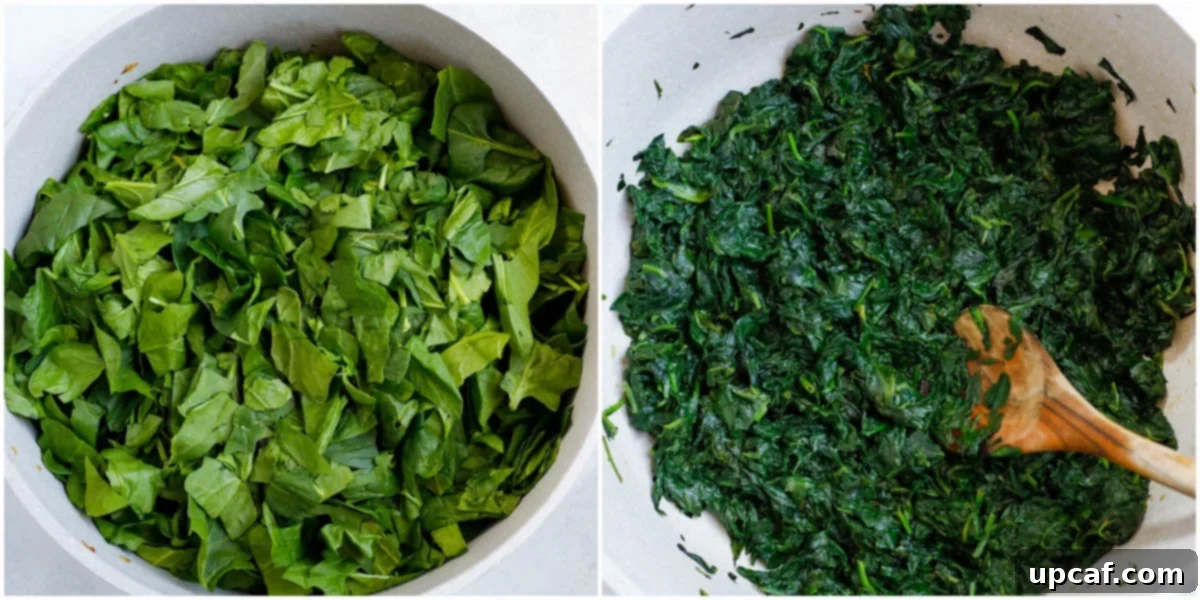
Next, prepare the onions. In a separate pan, sauté the petite diced onions with a tablespoon of olive oil over medium heat. Cook them until they become translucent and lightly caramelized. This process softens the onions and brings out their natural sweetness, ensuring they are tender and flavorful, not crunchy, in the final pie. While the onions are cooking, finely dice your fresh tomatoes.
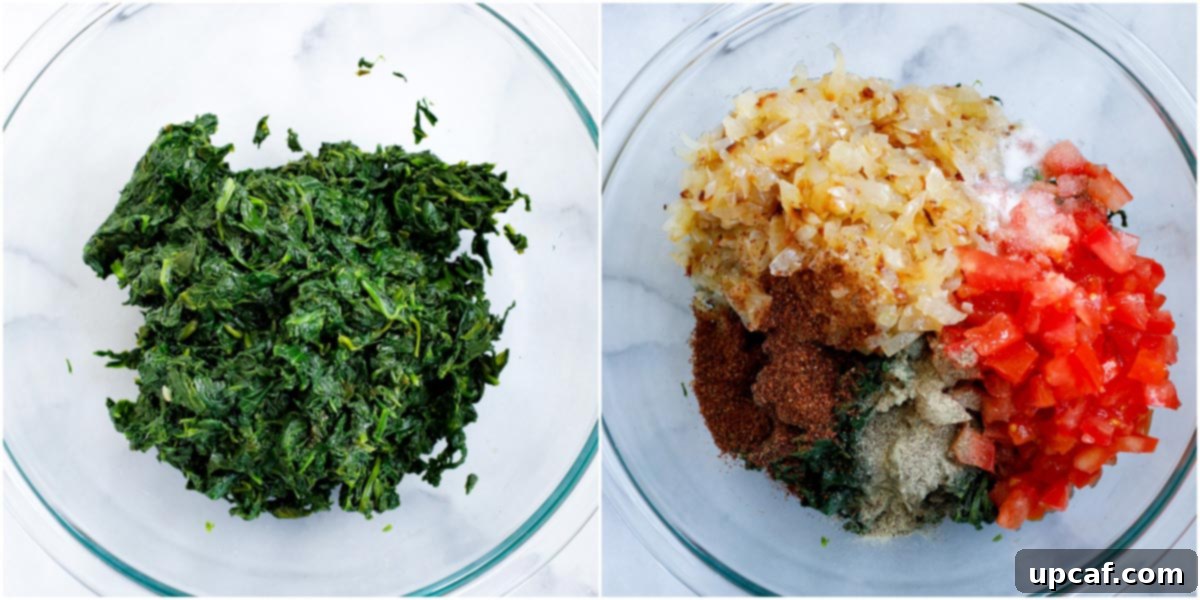
Finally, combine all the filling ingredients. In a large mixing bowl, bring together the thoroughly squeezed spinach, sautéed onions, diced tomatoes, salt, sumac, black pepper, and the optional cayenne pepper or chili flakes. If you’re using citric acid instead of lemon juice, add it now. Mix everything thoroughly to ensure all the flavors are evenly distributed. If using lemon juice, it’s best to mix it in just before you are ready to fill the pies to maintain its fresh acidity and prevent premature moisture release. Set the filling aside until your dough is ready.
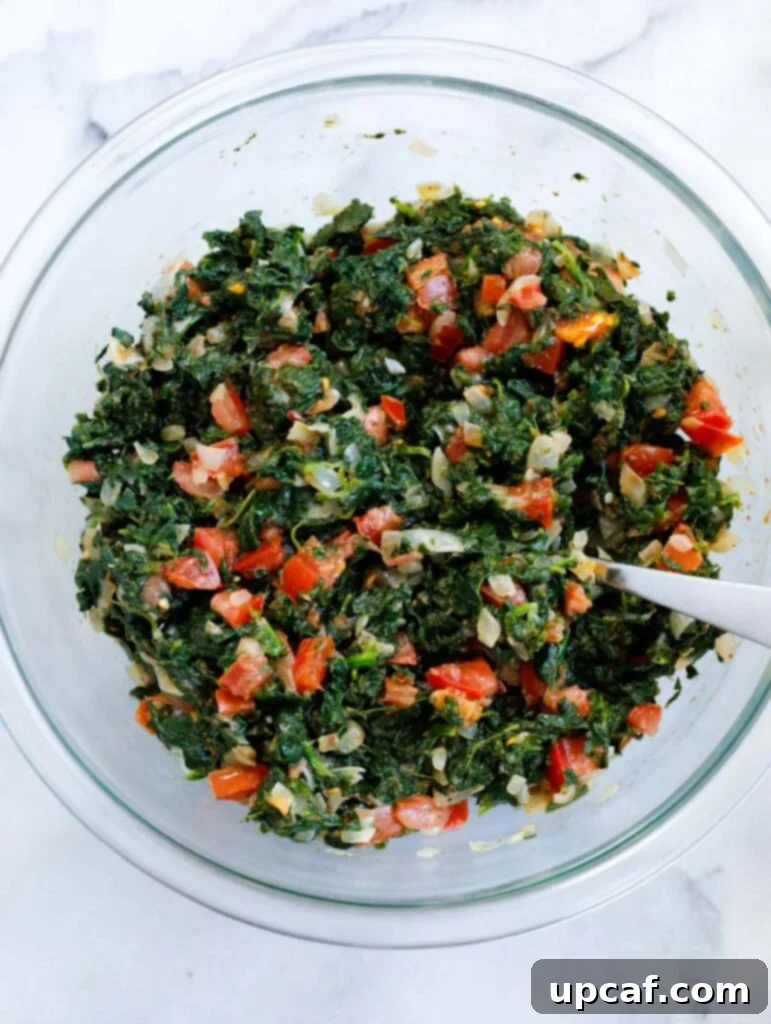
How to Assemble and Bake Lebanese Spinach Pies
With both your risen dough and flavorful filling ready, it’s time to bring these components together to create your delicious Lebanese Spinach Pies. This stage involves shaping the dough and baking the pastries to golden perfection.
Start by preheating your oven to 400°F (200°C). Then, gently remove the risen dough from its bowl onto a lightly floured surface, such as a marble slab or cutting board. Knead it briefly with your hands to deflate it and release any accumulated air. Divide the dough into small, even balls, aiming for consistency in size for uniform pies.
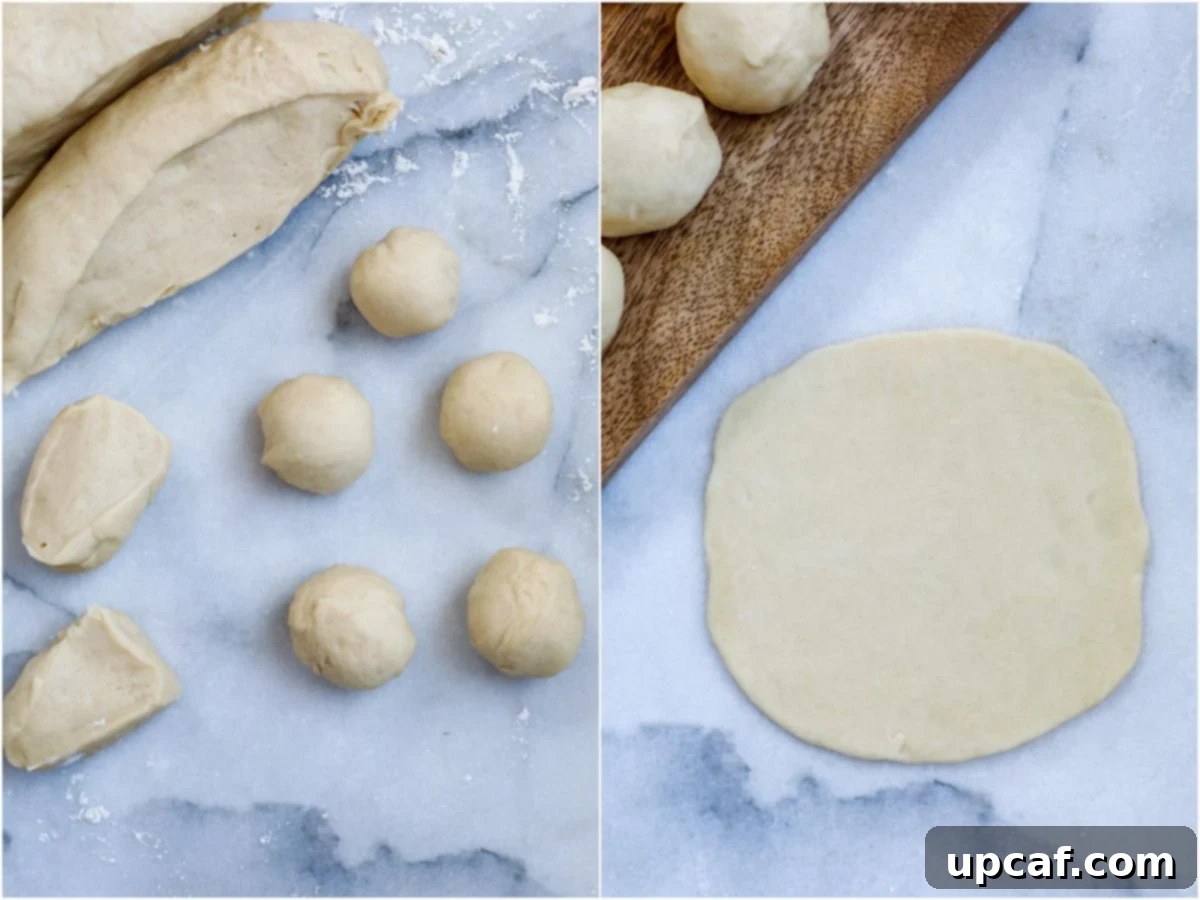
Pro Tip for Efficiency: To save time, instead of rolling each individual dough ball, you can roll out the entire dough into a large, thin sheet. Then, use a 3-inch cookie cutter or a round lid (like a mason jar lid) to cut out uniform circles. This method ensures consistent pie sizes and significantly speeds up the assembly process.

To assemble the fatayer, take one dough circle and place a heaping kitchen teaspoon of the spinach filling in its center. To form the characteristic triangle shape, carefully pick up two opposing sides of the round dough and bring them together, pinching them firmly to seal. Then, bring the remaining third side to meet the other two, pinching all edges together securely to form a perfect triangle. Ensure the edges are well-sealed to prevent the filling from escaping during baking. Repeat this process for the remaining dough circles and filling.
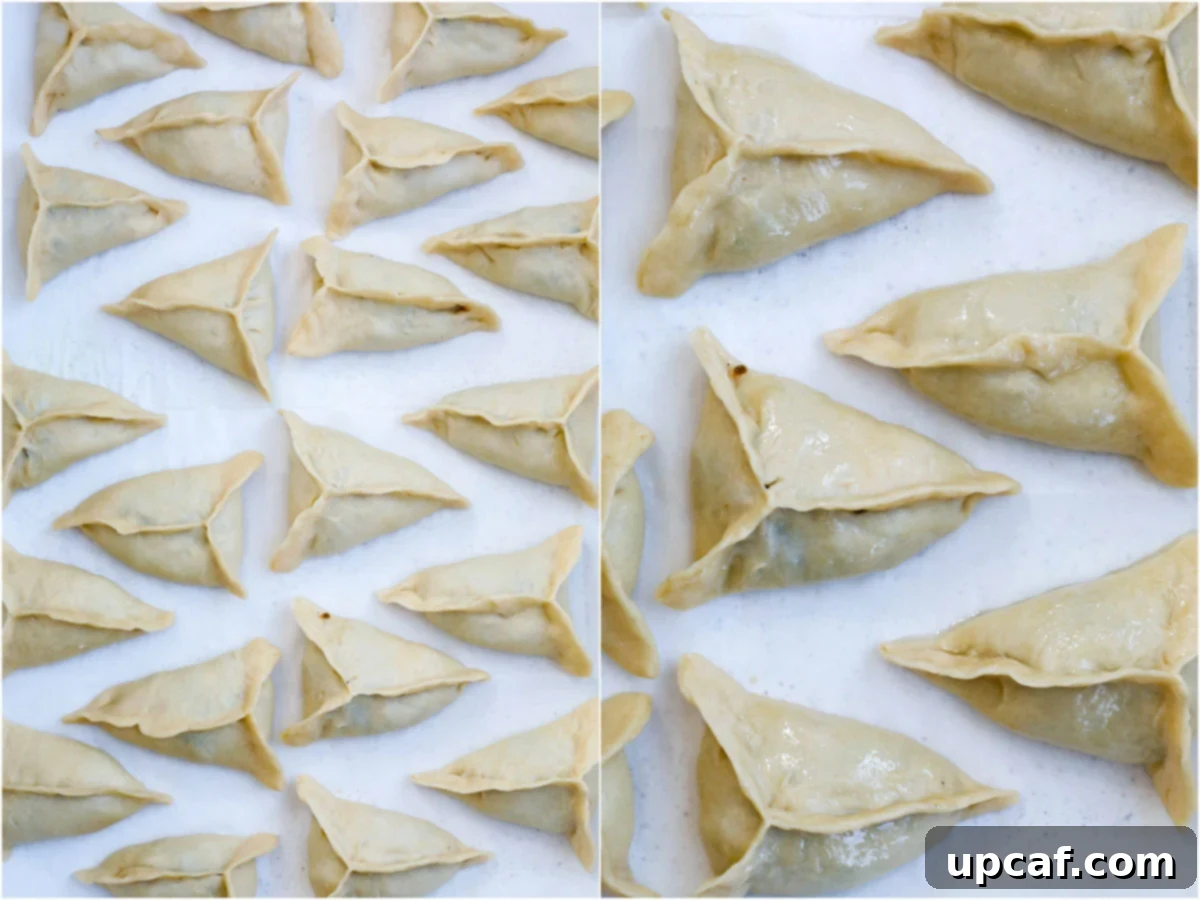
Arrange the shaped pies on a large baking sheet (or two, if necessary) lined with parchment paper, ensuring about an inch of space between each pie to allow for even baking. Brush the tops of the pies generously with a lightly flavored olive oil. Bake in the preheated oven for approximately 10 minutes. After this initial bake, brush them with a bit more olive oil and continue baking for another 5-10 minutes, or until they achieve a beautiful light golden brown color. Keep an eye on them, as oven temperatures can vary.

Once baked, remove the pies from the oven and let them cool for a minute or two on the baking sheet before transferring them to a serving platter. Serve these delicious Lebanese Spinach Pies warm, ideally with fresh lemon wedges on the side for an extra burst of zesty flavor.
Expert Tips for Crafting the Best Spinach Fatayer
Achieving perfectly tender dough and a flavorful, non-soggy filling for your Lebanese Spinach Pies requires attention to a few key details. Follow these tips for consistently delicious results:
- Thoroughly Drain the Spinach: This is arguably the most crucial step. Excess moisture from the spinach will inevitably lead to a soggy pie bottom, ruining the texture. Whether using fresh (blanched) or frozen spinach, squeeze it as dry as humanly possible using your hands or a clean kitchen towel.
- Roll the Dough Thin: Aim for a relatively thin dough when shaping your fatayer. A thinner dough yields a lighter, crispier pie with a delightful, flaky texture, allowing the filling to truly shine.
- Use Warm Liquids for Dough: Always ensure your milk and water are lukewarm (around 105-115°F or 40-46°C) when preparing the dough. This optimal temperature is vital for activating the yeast and ensuring a proper rise.
- Do Not Skip the Sumac: Sumac is non-negotiable for authentic Lebanese Spinach Pies. Its unique citrusy, tangy flavor is what gives fatayer its distinctive and beloved taste.
- For Extra Sourness: If you prefer a more pronounced sour kick, consider adding about 1 to 1.5 teaspoons of citric acid to the filling. While lemon juice adds flavor and freshness, citric acid provides a sharper, drier sourness, which can also help prevent excess moisture.
- Enhance Flavor with Pomegranate Molasses & Cayenne: For an additional layer of sweet-tart flavor, a tablespoon or two of pomegranate molasses is a wonderful optional addition. If you enjoy a touch of heat, a pinch of cayenne pepper or chili flakes will add a pleasant warmth.
- Add a Touch of Paprika: For a subtle warmth and a lovely reddish hue in your filling, consider adding a teaspoon of paprika. It enhances visual appeal and adds a gentle, complementary spice.
- Use Fresh Onions – No Substitutions: Fresh, petite-diced onions, sautéed until translucent and lightly caramelized, are essential. Do not substitute with frozen onions, and certainly do not omit them, as they contribute crucial sweetness and depth of flavor.
- Opt for Fresh Tomatoes: Similarly, always use fresh, finely diced vine tomatoes for the filling. Canned tomatoes have a different texture and moisture content that can negatively impact the final product.
Frequently Asked Questions About Lebanese Spinach Pies
Absolutely! Lebanese spinach pies are excellent for freezing, making them a fantastic make-ahead option. For best results when freezing, undercook the pies by about 5 minutes compared to a fully baked batch. This allows them to finish cooking perfectly upon reheating without becoming dry. To reheat, thaw them completely, brush lightly with olive oil, and bake at 400°F (200°C) for 10-15 minutes until warmed through and golden. This method ensures a crisp exterior and a tender interior.
Once your fatayer have cooled completely to room temperature, you can store them in an airtight container or a zip-top freezer bag. If stacking them, place a piece of parchment paper between layers to prevent them from sticking together. For short-term storage (1-2 days), keep them in the refrigerator. For longer storage, transfer them to the freezer, where they can last for up to 2-3 months.
Yes, you can use frozen spinach as a convenient alternative if fresh spinach isn’t available. However, it is imperative to thaw the frozen spinach completely and then squeeze out every last drop of liquid. This step is critical to prevent the filling from becoming watery and making the pie dough soggy. While fresh spinach is always highly recommended for its superior texture and vibrant flavor, properly prepared frozen spinach can still yield delicious results.
While homemade dough offers the best flavor and texture, you can certainly use premade dough for convenience. Rhodes dinner roll dough (the orange package, typically 36 rolls) is a popular choice for fatayer. If using premade dough, ensure you thaw it completely and allow it to rise according to package instructions before rolling it out thinly. This will still give you a delicious, albeit slightly different, result.
Explore More Authentic Lebanese Recipes
If you’ve enjoyed making these Lebanese Spinach Pies, you’re in for a treat with other staples of Lebanese cuisine. The rich flavors and fresh ingredients are characteristic of this vibrant culinary tradition. Discover more delightful dishes:
- Cabbage Fattoush Salad
- Lebanese Tabbouleh Salad
- Lebanese Shaabiyat recipe
- Lebanese Lentil Soup
- Lebanese Meat Pies

Whether served as a captivating appetizer, a light snack, or a fulfilling side dish, these Lebanese Spinach Pies (Fatayer Bi Sabanekh) are sure to impress. Their unique blend of tangy, savory, and comforting flavors makes them a favorite for any occasion. We sincerely hope you enjoy creating and savoring this authentic recipe, and that it brings a taste of Lebanese hospitality to your table.
If you try this delightful recipe and love it, please consider leaving a star rating and a comment below. Your feedback helps others discover these wonderful flavors! Also, be sure to follow Cookin’ With Mima on FACEBOOK | INSTAGRAM | PINTEREST for all the latest culinary inspirations and recipes!

Lebanese Spinach Pies
Ingredients
Spinach Filling
- 2 lbs fresh spinach, roughly chopped
- 2 tbsp olive oil, (to saute the spinach)
- 3 medium vine tomatoes, petite diced
- large onion, diced and caramelized
- 2 tbsp sumac
- 1 tsp black pepper
- 1/4 cup lemon juice, or replace with 1.5 tsp citric acid
- 1 tsp salt
- 3/4 tsp cayenne pepper, (optional to add heat)
- 2 tbsp pomegranate molasses, (optional)
Dough
- 4 cups all-purpose or bread flour
- 1 cup warm milk
- 1/3 cup warm water
- 1/2 cup vegetable or canola oil
- 2 tbsps sugar
- 1 1/2 tbsp active yeast
- 1 tsp baking powder
- 1/4 cup lightly flavored olive oil, for brushing only
Instructions
Making the dough
- Mix the yeast, warm water and sugar in a cup and let it sit for 10 minutes until the yeast mixture rises and doubles in size. This step is important to make sure the yeast is active.
- In an electrical mixing bowl, add all the dry ingredients. Start by adding in the yeast mixture and mix, then gradually add in the warm milk and oil. Continue kneading the dough on low speed for 1-2 minutes until the dough collects well together.
- Remove the dough from the mixer and form a round ball. Return to the bowl, cover with a towel or plastic wrap for 45-60 minutes until the dough doubles in size.
Making the filling
- Heat 1 tbsp. of olive oil in a large pot and sauté the chopped spinach until wilted. Next, transfer to a strainer and allow to drain and cool.
- Once the spinach has cooled, dice the tomatoes and sauté the diced onion with 1 tbsp olive oil until translucent and lightly caramelized.
- Return to the spinach. Squeeze thoroughly with your hands or a towel to remove all excess water.
- In a bowl, combine the squeezed spinach, sautéed onions, diced tomatoes, salt, sumac, black pepper, and optional cayenne pepper or citric acid (if using instead of lemon juice). Mix well. If using lemon juice, mix in just before filling the pies.
Assembling the Spinach Pies
- Pre-heat the oven to 400 degrees F (200°C).
- Remove the dough from the bowl, sprinkle with flour, and knead briefly to deflate. Divide the dough into small, even balls.
- Alternatively, roll the dough into a large piece and cut out 3-inch circles with a cookie cutter for consistent sizing.
- Place a heaping teaspoon of filling onto each dough circle. Fold two sides of the dough together and pinch to seal, then bring the third side to meet them, forming a triangle. Ensure all edges are securely pinched to prevent opening during baking. Repeat for all pies.
- Place the shaped pies on a parchment-lined baking sheet, leaving 1 inch between them. Brush generously with lightly flavored olive oil. Bake for 10 minutes, then brush with more olive oil and continue baking for another 5-10 minutes until golden brown.
- Remove from the oven and let cool for a minute or two before serving. Serve with lemon wedges.
Notes
- Drain the spinach really well to prevent soggy bottoms. This is crucial for successful pies.
- Roll the dough as thin as possible for lighter, crispier, and flakier pies.
- Use only warm milk and water for the dough to ensure proper yeast activation and rise.
- Do not skip the sumac; it’s essential for the authentic tangy flavor.
- For extra sourness, add 1-1.5 tsp citric acid. This can also help reduce moisture compared to adding more lemon juice.
- Add pomegranate molasses for a sweet-tart depth and cayenne pepper or chili flakes for optional heat.
- A teaspoon of paprika can add a subtle color and warmth to the filling.
- When freezing, undercook pies by about 5 minutes. Thaw, brush with olive oil, and finish baking at 400°F (200°C) for 10-15 minutes to reheat and crisp.
- Store cooled pies in an airtight container or zip-lock freezer bag. Use parchment paper between layers if stacking to prevent sticking.
Nutrition
Like this recipe? Rate and comment below!
